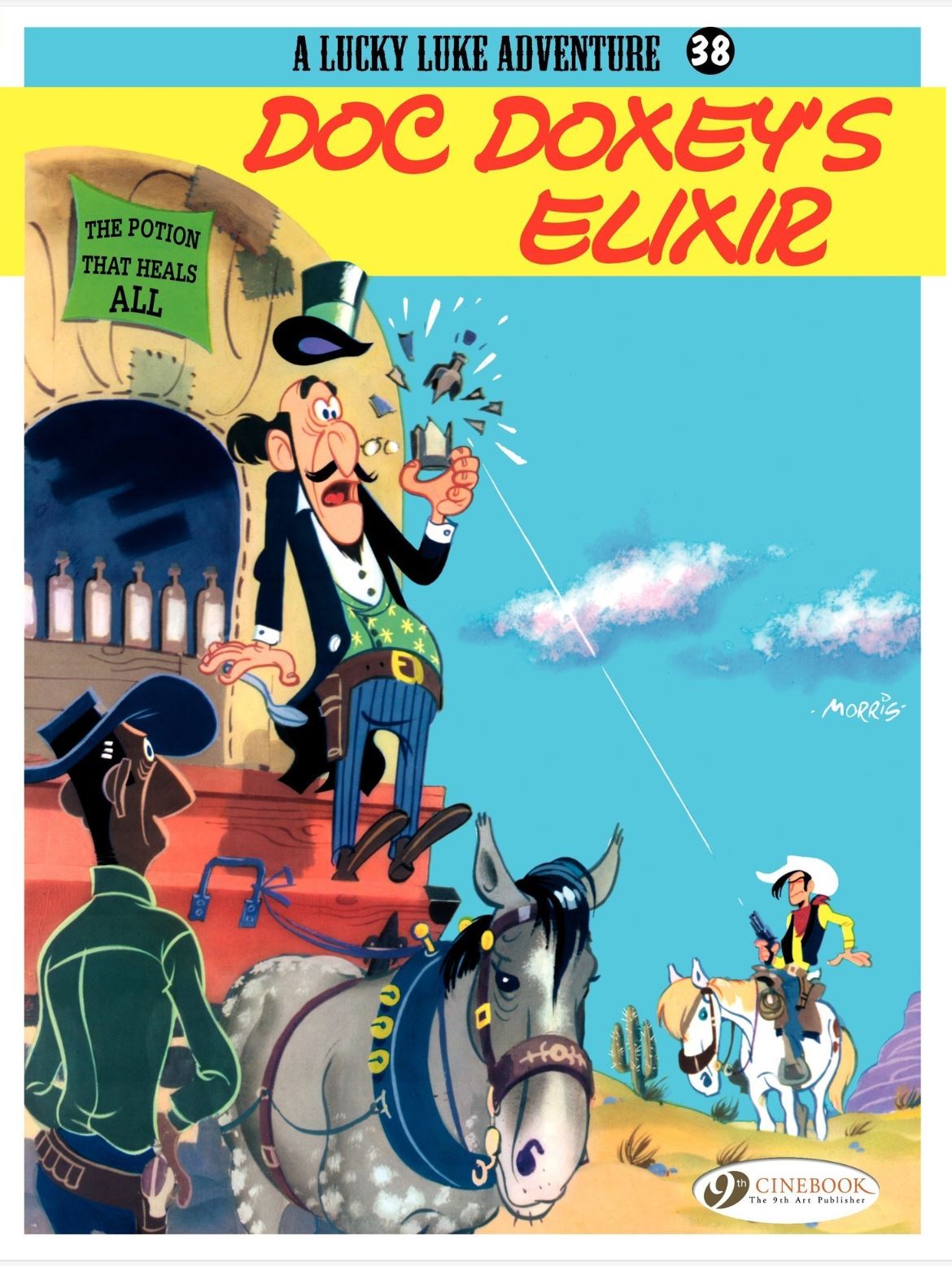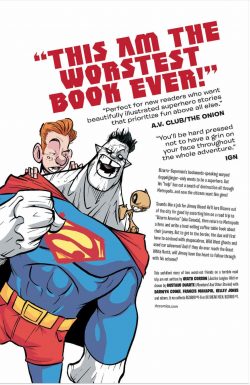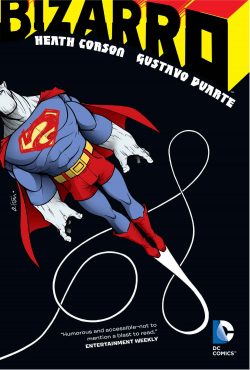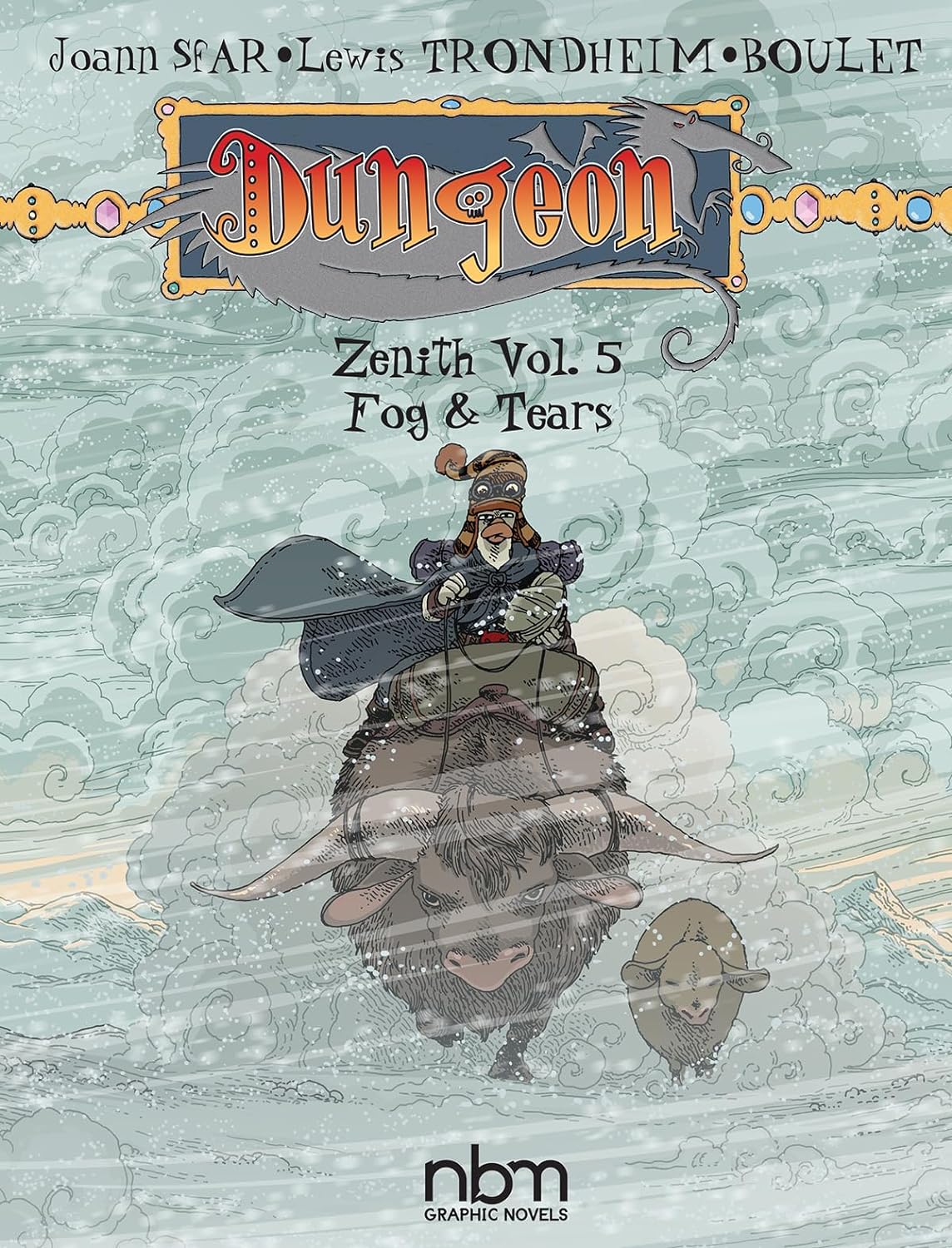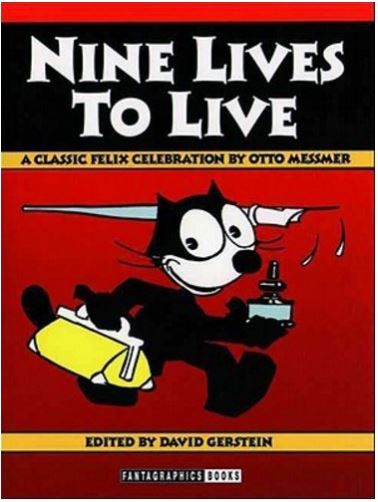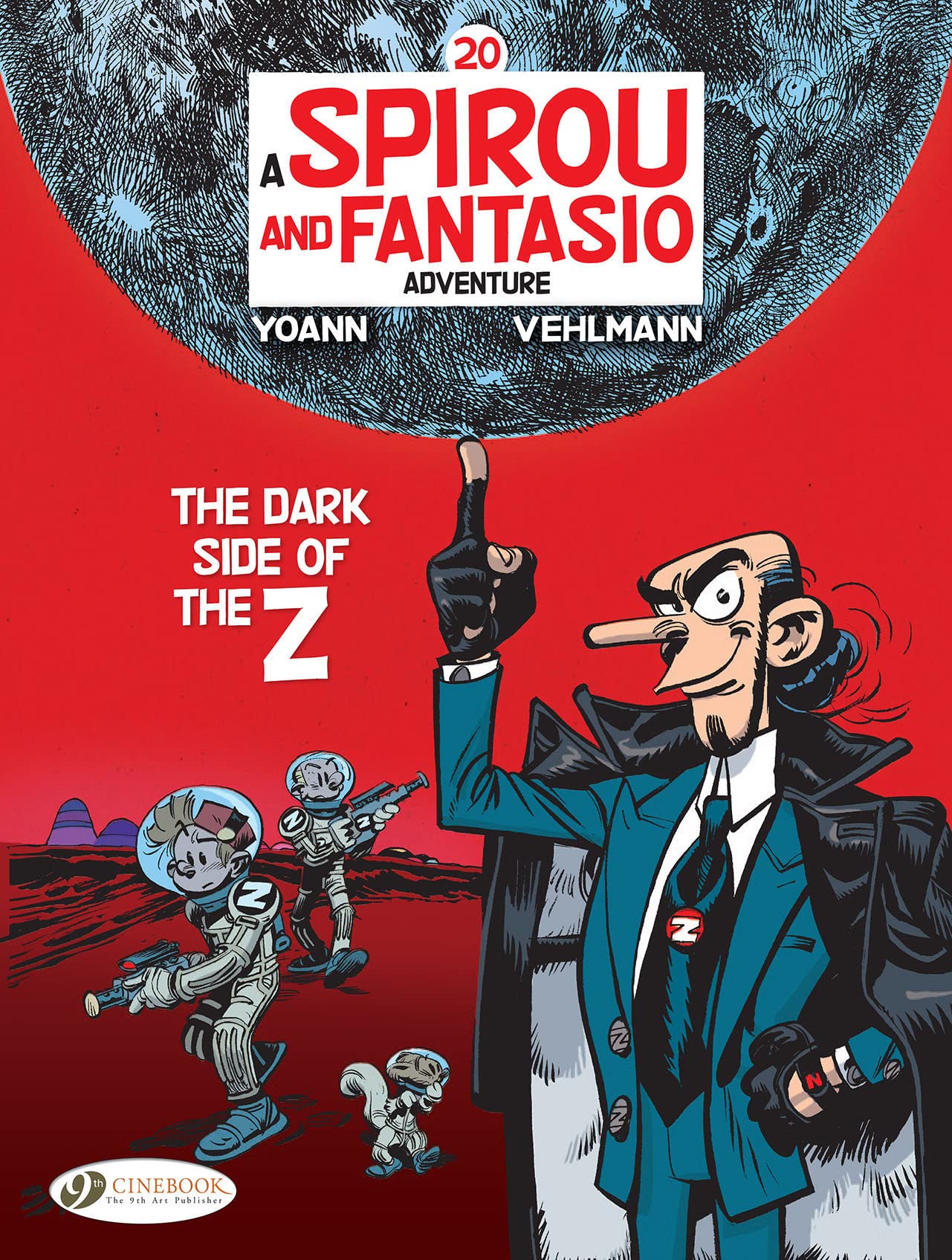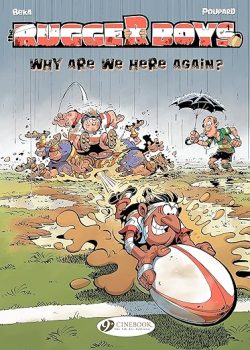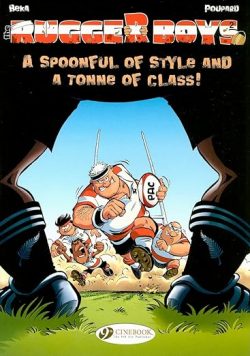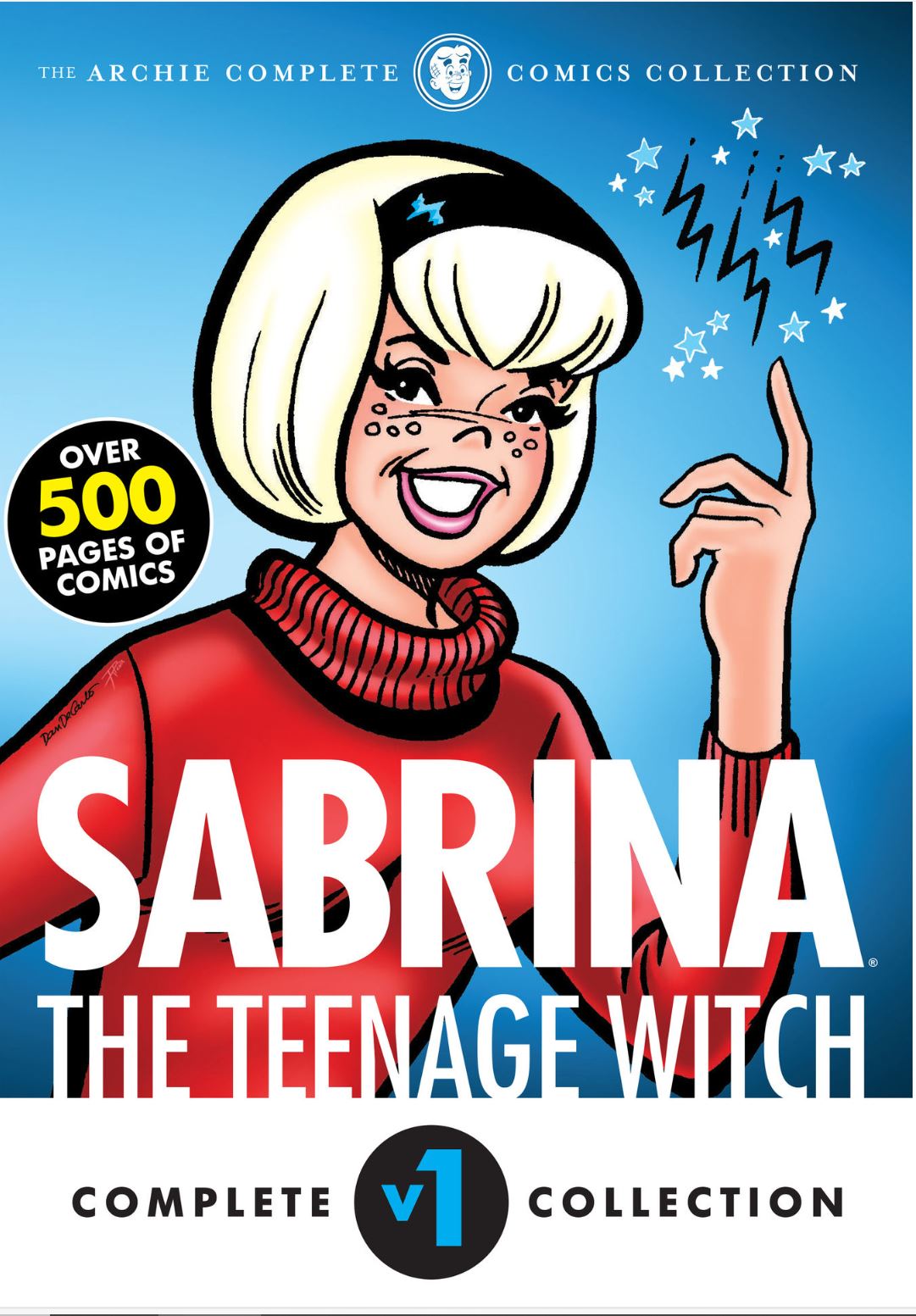
By George Gladir, Frank Doyle, Dick Malmgren, Al Hartley, Dan DeCarlo, Joe Edwards, Rudy Lapick, Vince DeCarlo, Bob White, Bill Kresse, Bill Vigoda, Mario Acquaviva, Jimmy DeCarlo, Chic Stone, Bill Yoshida, Stan Goldberg, Jon D’Agostino, Gus LeMoine, Harry Lucey, Marty Epp, Bob Bolling, Joe Sinnott & various (Archie Comic Publications)
ISBN: 978-1-936975-94-5 (TPB/Digital edition)
Created by George Gladir & Dan DeCarlo, Sabrina the Teen-Age Witch premiered in Archie’s Mad House #22 (cover-dated October 1962): a throwaway character in a gag anthology which was simply one more venue for comics’ undisputed kings of kids comedy. She proved popular enough to become a regular in the burgeoning cast surrounding the core stars Archie Andrews, Betty Cooper, Veronica Lodge and Jughead Jones.
By 1969, the high school enchantress had grown popular enough to win her own animated Filmation TV series (just like Archie and Josie and the Pussycats) and graduated to a lead position in Archie’s TV Laugh Out before finally winning her own title in 1971.
That first volume ran 77 issues (from 1971-1983) and, when a hugely successful live action TV series launched in 1996, ed comic book adaptation followed in 1997. That version folded in 1999 after a further 32 issues.
Volume 3 – simply entitled Sabrina – was based on new TV show Sabrina the Animated Series ran for 37 issues (2000- 2002) before a back-to-basics reboot saw the comic revert to Sabrina the Teenage Witch with #38, carefully blending elements of all previous print and TV versions.
A creature of seemingly infinite variation and variety, the mystic maid continued in this vein until 2004 and issue #57 wherein – acting on the global popularity of Japanese comics – the company switched format: transforming series into a manga-style high school comedy-romance in the classic Shoujo manner.
Another recent version abandoned whimsy altogether, depicted Sabrina as a vile and seductive force of evil in Chilling Adventures of Sabrina. This no-frills. massively monochrome compilation re-presents all her appearances – even cameos on covers of other Archie titles – from that first decade, starting with an informative and educational Introduction courtesy of Editor-in-Chief Victor Gorelick before unleashing the wonderment in a year-by-year cavalcade of magic, mystery and mirth.
Clearly referencing Kim Novak as seen in Bell, Book and Candle, ‘Presenting Sabrina the Teenage Witch’ (George Gladir, Dan DeCarlo, Rudy Lapick & Vince DeCarlo from Archie’s Mad House #22) showcased a sultry seductress with a wicked edge preying on mortals at the behest of Head Witch Della, all whilst secretly hankering for the plebeian joys of dating…
Leading off the next year’s chapter, the creatives reunited in Archie’s Mad House #24 (February 1963), with ‘Monster Section’ depicting Sabrina bewitching boys the way mortal girls always have, whilst ‘Witch Pitch’ sees the young beguiler ordered to ensorcel the High School hockey team – with mixed results…
AMH #25 (April) focuses on the supernatural clan’s mission to destroy human romance. In ‘Sister Sorceress’ Della orders Sabrina to split up dating couple Hal and Wanda – with catastrophic results – before ‘Jinx Minx’ (#26, June) sees Sabrina go too far with a love potion at a school dance…
Bob White’s Archie’s Mad House #27 cover (August 1963) leads into #28’s ‘Tennis Menace’ (inked by Marty Epp) as Sabrina’s attempts to enrapture a rich lad go infuriatingly awry. AMH #30 (December) offers pin-up ‘Teen-Age Section’ drawn by Joe Edwards, with Sabrina comparing historical ways of charming boys with modern mortal methods…
The 1964 material opens with a love potion pin-up ‘Teen Section’ by Edwards (AMH #31, February) before Gladir & Edwards’ ‘Ronald the Rubber Boy Meets Sabrina the Witch Queen’ finds the magic miss disastrously swapping abilities with an elastic-boned pal.
Issue #36 (October, by Edwards) sees her failing to jinx her friends’ recreational evening in ‘Bowled Over’, after which (AMH #37, December) finds Gladir reunited with Dan & Vince DeCarlo for a spot of ‘Double Trouble’ when gruesome Aunt Hilda tries to fix Sabrina’s appalling human countenance, only to become her unwilling twin…
In 1965 Sabrina’s only appearance was a Harry Lucey-limned ad for Archie’s Mad House Annual, whereas a year later she triumphantly returned with illustrator Bill Kresse handling Gladir’s script for ‘Lulu of a Boo-Boo’ (AMH #45, February 1966). Here the witch-girl’s attempts to join the In-Crowd constantly misfire whilst ‘Beach Party Smarty’ (#48, August) confirms this new trend, as her spells to capture a hunky beau go badly wrong…
For ‘Go-Go Gaga’ (AMH #49, September) Gladir & Kresse pit the bonny bewitcher against a greedy entrepreneur planning to fleece school kids in his over-priced dance hall, whilst #50’s ‘Rival Reversal’ finds her failing to conjure a date before ‘Tragic Magic’ proves even sorcery can’t keep a teen’s room clean…
Art team Bill Vigoda & Mario Acquaviva join Gladir for 1967’s first tale. ‘London Lore’ (AMH #52, February) with Sabrina transporting new boyfriend Donald to the heart of the Swinging Scene (it meant something else back then) but ill-equipping him for debilitating culture-shock, after which ‘School Scamp’ (Gladir + Dan, Jimmy & Vince DeCarlo, from AMH #53, April) again proves magic has no place in human education…
In #55 Gladir, Dan DeCarlo & Lapick prove Sabrina’s wishing to help a doubly dangerous proposition in ‘Speed Deed’, whilst in #58 (December, Chic Stone & Bill Yoshida) the trend for ultra-skinny fashion models leads to a little shapeshifting in ‘Wile Style’…
1968 opens with Gladir, Stone & Yoshida exploring the downside of slot-car racing in ‘Teeny-Weeny Boppers’ (AMH #59, February) after which ‘Past Blast’ (#63, September by Gladir, Stan Goldberg, Jon D’Agostino & Yoshida) sees our mystic maid time-travel in search of Marie Antoinette, Pocahontas and Salem sorceress Hester. The year wraps up with ‘Light Delight’ (Gladir, White, Acquaviva & Yoshida: AMH #65, December) as Sabrina’s aunts Hilda and Zelda try more modern modes of witchy transport…
With Sabrina’s television debut, the end of 1969 saw a sudden leap in her comics appearances to capitalise on the exposure and resulted in a retitling of her home funnybook. Again crafted by Gladir, White, Acquaviva & Yoshida, ‘Glower Power’ comes from Mad House Ma-Ad Jokes #70 (September) with her duelling another teen mage before the cover of Archie’s TV Laugh-Out #1 (December: by Dick Malmgren & D’Agostino) leads into ‘Super Duper Party Pooper’ and the instant materialisation of a new sitcom lifestyle for the jinxing juvenile.
Sabrina yearns to be a typical High School girl. She lives in suburban seclusion with Hilda & Zelda and Uncle Ambrose. She has a pet cat – Salem – and is tentatively “seeing” childhood pal Harvey Kinkle. The cute but clueless boy reciprocates the affection, but is far too scared to rock the boat by acting on his own desires.
He has no idea that his old chum is actually a supernatural being…
This opening sally depicts what happens when surly Hilda takes umbrage at the antics of Archie and his pals after they come over for a visit, whilst ‘Great Celestial Sparks’ (pencilled by Gus LeMoine) reveals what lengths witches go to when afflicted with hiccups…
A full-on goggle-box star, Sabrina blossomed in 1970, starting with a little flying practice in ‘Broom Zoom’; boyfriend trouble in ‘Hex Vex’; fortune-telling foolishness in ‘Hard Card’; amulet antics in ‘Witch Pitch’ and kitchen conjurings in ‘Generation Gap’: all by Gladir, LeMoine, D’Agostino & Yoshida from Mad House Ma-Ad Jokes #72 (January). The issue also offered sporting spoofs in ‘Bowl Roll’ (Dan DeCarlo).
The so-busy cover of Archie’s TV Laugh-Out #2 (March 1970) segues into Gladir, Dan D, Lapick & Yoshida’s ‘A Plug for The Band’ with Sabrina briefly joining The Archies’ pop group, whilst LeMoine contributes a brace of half-page gags – ‘Sassy Lassy’ and ‘Food Mood’ – and limns ‘That Ol’ Black Magic’, wherein the winsome witch’s gifts cause misery to all her new friends in Riverdale…
Dan D’s & Lapick’s June cover for Archie’s TV Laugh-Out #3 leads into Malmgren-scripted ‘Double Date’, with hapless Harvey causing chaos at home until Ambrose finds a potential putrid paramour for Aunt Hilda. The creatives then launch an occasional series on stage magic with ‘Sabrina Tricks’ pages, before single-pagers ‘Goodbye Mr. Chips’, ‘The Hand Sandwich’, ‘The Sampler’, ‘Never on Sundae’ and ‘Finger Licken Good’ reveal a growing divide between house-proud Hilda and accident-prone, ever-ravenous Harvey.
Interspersed by three more ‘Sabrina Tricks’ pages, mystic mayhem continues with mini-epic ‘I Wanna Hold Your Hand’ (Malmgren, LeMoine, D’Agostino & Yoshida) as our witch girl disastrously attempts to make Jughead Jones more amenable to Big Ethel’s amorous overtures. The food fiascos resume with LeMoine-limned ‘Good and Bad’, as Sabrina’s every good intention is accidentally twisted to bedevil her human pals.
Taken from Mad House Glads #74 (August 1970), Gladir & LeMoine’s half-page chemistry gag ‘Strange Session’ is oddly balanced by the painterly ‘Blight Sight’ of long-forgotten never-was Bippy the Hippy, before we’re back on track and at the beach for Archie’s TV Laugh-Out #4 (September, by Gladir, Vigoda, Lapick & Yoshida). In ‘To Catch a Thief’ Sabrina again assists Ethel in pinning down elusive, love-shy Jughead, and rounding out the issue are single page pranks ‘Beddy Bye Time’ (DeCarlo & Lapick), another ‘Sabrina Tricks’ lesson and seaside folly ‘In the Bag’ from LeMoine & D’Agostino.
ATVL-O #5 (November) offers up Gladir, Vigoda & Stone’s ‘I’ll Bite’ as Sabrina’s hungry schoolfriends learn the perils of raiding Hilda’s fridge and Gladir, DeCarlo & Lapick’s ‘Hex Vex’ as Della storms in, demanding tardy Sabrina fulfil her monthly quota of bad deeds…
Sabrina is an atypical witch: living in the mundane world and assiduously passing herself off as normal, and 1971 opens with DeCarlo & Lapick’s cover for Archie’s TV Laugh-Out #6 (February) and ‘Match Maker’ by Frank Doyle, Harry Lucey & Epp as Hilda tries getting rid of Harvey by making him irresistible to Betty & Veronica. No way that can go wrong…
‘Sabrina the Teen-Age Witch’ (Gladir, LeMoine, D’Agostino & Yoshida) then uses her powers openly with some kids and learns a trick even ancient crone Hilda cannot fathom. Bolstered by a ‘Sabrina Tricks’, ‘Carry On, Aunt Hilda’ (Malmgren, LeMoine & Lapick) hilariously depicts lucky stars shielding Harvey from the wrath of irascible Aunt Hilda…
Bowing to popular demand, the eldritch ingenue finally starred in her own title from April 1971. Dan D & Lapick’s cover for Sabrina the Teen-Age Witch #1 hinted at much mystic mirth and mayhem which began with ‘Strange Love’ (Doyle, Dan D & Lapick). This revealed a jealous response to seeing Harvey with another girl, supplemented by ‘Sabrina and Salem’s Catty Quiz’ before hippy warlock Sylvester comes out of the woodwork to upset Hilda’s sedate life in ‘Mission Impossible’ (Malmgren, LeMoine & D’Agostino).
Another ‘Sabrina Puzzle’ neatly moves us to Doyle, Dan D & Lapick’s ‘An Uncle’s Monkey’ with Harvey and a pet chimpanzee pushing Hilda to the limits of patience and sanity…
The cover of Archie’s TV Laugh-Out #7 (May) precedes a long yarn by Doyle, Bob Bolling & D’Agostino as ‘Archie’s TV Celebrities’ (the animated Archies, Sabrina and Josie and the Pussycats) star in ‘For the Birds’ with a proposed open-air concert threatened by the protests of a bunch of old ornithology buffs.
Thanks to Malmgren, LeMoine & D’Agostino, our celebrity pals tackle an instrument-stealing saboteur in ‘Sounds Crazy to Me’, before Sabrina cameos on the cover of Jughead #192 (May, by Dan DeCarlo & Lapick) before heading for the cover of her second issue (DeCarlo & Lapick, July). Within those pages Malmgren scripts ‘No Strings Attached’ as The Archies visit their bewitching buddy just as Hilda turns Harvey into an axe-strumming rock god…
‘Witch Way is That’ sees Hilda quickly regret opening her house to Tuned In, Turned On, Dropped Out Cousin Bert, prior to Malmgren, Lucey & Epp showing Archie suffering the jibes and jokes of ‘The Court Jester’ Reggie – until Sabrina adds a little something extra to the Andrews boys’ basketball repertoire..
At this time the world underwent a revival of supernatural interest and Gothic Romance was The Coming Thing. In a bold experiment, Sabrina had a shot at a dramatic turn as Doyle, Bolling, Joe Sinnott & Yoshida crafted ‘Death Waits at Dumesburry’: a relatively straight horror/mystery with Sabrina facing a sinister maniac in a haunted castle she inherits…
Rendered by LeMoine & D’Agostino, the cover of Jughead’s Jokes #24 (July 1971) brings us back to comedy central, as does their cover for Archie’s TV Laugh-Out #8 (August) and Malmgren’s charity bazaar-set tale ‘A Sweet Tooth’, with the winsome witch discovering even her magic cannot make Veronica’s baked goods edible…
Dan DeCarlo’s cover for Sabrina the Teen-Age Witch #3 (September) foreshadows a return to drama but in modern milieu as ‘House Breakers’ (Malmgren, DeCarlo & Lapick) finds Harvey and Sabrina stranded in an old dark mansion with spooks in situ, after which ‘Spellbinder’ (Doyle, Al Hartley) sees Hilda cringe and curse when human catastrophe Big Moose pays Sabrina a visit.
Hartley & D’Agostino fly solo on ‘Auntie Climax’ as irresistibility spells fly and both Archie and Hilda are caught in an amorous crossfire before Malmgren, Bolling & Lapick show our cast’s human side in ‘The Tooth Fairy’ as Archie, Jughead and Sabrina intervene to help a juvenile thief caught in a poverty trap …
A trio of DeCarlo & Lapick covers – Archie’s TV Laugh Out #9 (September), Archie’s Pals ‘n’ Gals #66 (October) and Sabrina the Teen-Age Witch #4 (October) segue into the teen thaumaturge’s fourth solo issue, where Doyle, Goldberg & D’Agostino set the cauldron bubbling with ‘Hex Marks the Spot’ as Aunts Hilda and Zelda nostalgically opine for their adventurous bad old days but something seems set on thwarting every spell they cast, after which ‘Which Witch is Right?’ (LeMoine pencils) finds obnoxious Reggie Mantle uncovering Sabrina’s sorcerous secrets.
Goldberg & Sinnott illustrate ‘Switch Witch’ as officious Della suspends Sabrina’s powers as a punishment and can’t understand why the girl is delirious instead of heartbroken, whilst Hartley & Sinnott contribute a run of madcap one-pagers from Gladir, Malmgren and Doyle with clue-packed titles such as ‘Out of Sight’, ‘Beauty and the Beast’, ‘The Teen Scene‘, ‘So That’s Why’ and ‘Time to Retire’.
Wrapping up the issue is ‘The Storming of Casket Island’ by Doyle, LeMoine & D’Agostino, blending stormy sailing, sinister swindling skulduggery and menacing mystic retribution…
More covers follow: Archie #213 and Archie’s TV Laugh Out #10 (both November by Dan D & Lapick) and Archie’s Christmas Stocking #190 (December, Hartley & D’Agostino), which latter also contributes Hartley & Sinnott’s ‘Card Shark’, with Sabrina joining Archie and the gang to explore the point and purpose of seasonal greetings postings. DeCarlo & Lapick’s cover of Betty and Me #39 brings the momentous year to a close…
The last year covered in this titanic tome is 1972, kicking off with DeCarlo & Lapick’s cover for Archie Annual #23, before their Sabrina’s Christmas Magic #196 cover (January) opens on a winter wonderland of seasonal sentiment. It all starts with ‘Hidden Claus’ (by featured team Hartley & Sinnott) as Sabrina ignores her aunt’s mockery and seeks out the real Father Christmas – just in time to help him with an existential and labour crisis…
‘Sabrina’s Wrap Session’ offers tips on gifting and packaging whilst ‘Hot Dog with Relish’ sees the witch woman zap Jughead’s mooching canine companion and make him a guy any girl could fall for. Doyle, Goldberg & Sinnott concocted ‘The Spell of the Season’, depicting our troubled teen torn between embracing Christmas and wrecking it as any true witch would. Guess which side wins the emotional tug-of-war?
More handicraft secrets are shared in ‘Sabrina’s Instant Christmas Decorations’ before Hartley & Sinnott’s ‘Sabrina Asks… What Does Christmas Mean to You?’ and ‘Sabrina Answers Questions About Christmas’, after which cartoon storytelling resumes with ‘Mission Possible’ as Hilda & Zelda find their own inner Samaritan.
Despite a rather distressing (and misleading) title ‘Popcorn Poopsie’ reveals a way of making tasty decorative snacks whilst ‘Sabrina’s Animal Crackers’ tells a tale of men turned to beasts before a yuletide ‘Sabrina Pin-Up’ and exercise feature ‘Sabrina Keeps in Christmas Trim’ return us to the entertainment section.
An all-Hartley affair, ‘Sabrina’s Witch Wisher’ examines what the vast cast would say if given a single wish, after which Doyle, Goldberg & Sinnott conclude this mammoth meander down memory lane by revealing how an evil warlock was punished by becoming ‘A Tree Named Obadiah’. Now – decked out in lights and tinsel – he’s back and making mischief in Veronica’s house…
An epic, enticing and always enchanting experience, the classic adventures of Sabrina the Teenage Witch are sheer timeless comics delight that no true fan will ever grow out of – and who says you have to?

© 1962-1972, 2017 Archie Comic Publications, Inc. All rights reserved.
